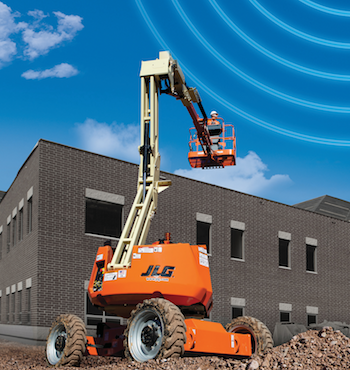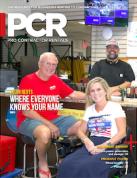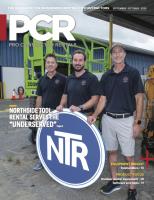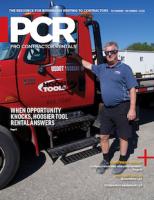Build your business: The wait is over
Telematics is the new normal.
Did you know that telematics in construction equipment has been around for more than 20 years? Large mining equipment manufacturers were among the first companies to introduce the technology, and contractors and end-users quickly saw the benefits – maximum uptime, cost savings on service, equipment security and increased productivity, to name a few.
 |
| In most cases, the investment will be returned for every machine that runs telematics in less than one year. |
So why has it taken so long for the remaining construction sectors to adopt telematics?
It would be rare to meet with someone in the construction equipment rental business or individual equipment owners who would say they aren’t aware of telematics, but you will talk with plenty who have yet to begin taking advantage of this cost-saving technology – one that can significantly extend the life of construction equipment and positively impact profitability.
The latest estimates show that less than 30 percent of equipment rental companies are currently leveraging telematics on their fleets, however experts agree that this will soon change. As data becomes more affordable and manageable, rental businesses will quickly realize how this technology can make them money, causing adoption rates to accelerate. By more accurately managing the service needs of their fleet and therefore keeping equipment running longer, rental companies and end users will see major returns on uptime, reliability, productivity and profitability.
According to Guru Bandekar, JLG vice president of engineering, “There are many reasons why construction equipment rental companies have been late adopters of telematics. From upfront investment concerns and general lack of understanding, to the fear of managing the data and the anxiety over related IT concerns, fleet owners are often overwhelmed by the number of options available when making the decision.”
Not as costly
But it really doesn’t need to be complicated or costly. “In most cases, the investment will be returned for every machine that runs telematics in less than one year. While the data points can be endless and perhaps provide more detail than most would initially need, not all the information needs to be used at the same time. Owners can easily fine-tune the data into workable amounts that can later be enhanced as IT skills improve or the decision is made to hire technical experts,” says Bandekar.
If rental companies aren’t convinced that telematics can improve business and increase profitability, there’s an even bigger reason that they should make this technology part of their future plans. Many construction contractors are now demanding equipment that utilizes telematics data. To them, it’s becoming as basic as having a smartphone.
The construction industry faces productivity issues daily. Telematics is a major driver in boosting the performance of equipment as well as a catalyst for keeping workers busy and meeting deadlines.
“Over the course of a construction project’s lifecycle, more than 40 percent of time can be wasted looking for equipment and materials,” says Bandekar. “A fully deployed telematics solution can theoretically cut that number down to zero. So even at the most basic level of use – GPS location of equipment – the technology is an obvious choice for those looking to improve efficiency on a job site.”
The technology is much more advanced than most realize. By providing the ability to turn equipment on and off based on an operator’s safety credentials, security features that cut down on theft and the ability to track delivery of equipment from the time it leaves the rental yard to when it arrives on site, telematics has a significant impact across the entire construction project. Most software packages can establish geofences, which are invisible lines based on GPS coordinates that disables equipment if it is moved outside the job site. It can even remotely alert managers the equipment has been moved outside of the geofence.
Rental equipment owners and construction site superintendents will also appreciate the ability to monitor how machines are being used, how long the equipment is operating each day and the critical advantage of easily monitoring battery usage – including whether or not equipment has been plugged in for charging at the end of the day. All of these facets of telematics can greatly improve productivity on a job site, often helping projects to stay on target for completion or helping contractors plan for delays.
Data ownership
The question often arises of who owns the data? It has been discussed and debated extensively in trade media and among OEMs and fleet owners. “From JLG’s perspective, the company simply recognizes the added value that telematics provides for customers and end users. While no customer is required to provide equipment data back to the company, every OEM pursues the information because each one recognizes how useful it is for product development. Allowing manufacturers to harness the data can only improve the end product, which in turn continues to improve the equipment owner’s bottom line,” says Bandekar.
“As access technology leaders, JLG believes that shared data will help us to continue reinventing our products, to develop new, more innovative equipment solutions and to help drive toward fully connected job sites in the very near future,” Bandekar adds, “Connected sites are the future – there is no arguing that fact – and fleet owners and contractors will need a way to manage equipment in real time.”
Job sites seem to only be expanding in size and complexity, which makes meeting deadlines increasingly important. Telematics is not something to be feared. It is one of the single easiest and affordable decisions you can make for your fleet.
Finding useful ways to harness the collected data does not need to be a daunting task. Your OEMs or technology providers are experts that can help get you on the path to improving equipment profitability that might otherwise be lost without telematics.
Korry Kobel is director of engineering at JLG.
Copyright 2019 Urbain Communications, LLC. All rights reserved. Contact curbain@urbaincomm.com for permission to reprint or rebroadcast all or part of this article.










